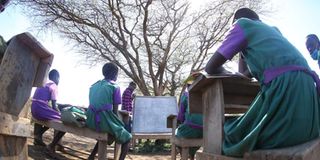Learning under trees a sign of poor leadership

Grade four pupils of Ng’ambo Primary School study under a tree at Seriani in Baringo South on January 4, 2021 on the first day of schools' reopening after the school submerged in water.
What you need to know:
- Learning under trees may have been a reality in the past, but not now.
- All Kenyan children deserve to learn in a dignified environment.
There are reasons why things happen the way they do. One of the reasons is called context. It’s imperative that we get to understand the various contexts that make particular occurrences to be seen as good or bad.
For instance, if we don’t understand the context of gender-based violence and the ways in which it is insidiously held together by other systems like patriarchy, religion, culture, judicial ineptitude and so on, we can’t progressively solve the issue.
Another example is the context of police brutality and why its an outright violation of the poorest people. Police brutality is deeply classist, which means it’s carried out on those seen as replaceable, vulnerable or lacking in social standing.
Our understanding of class is thus necessary if we are to seek long-term solutions to police brutality. There are many other instances where context is needed yet it’s always neglected. Context is where all clarity lies and if there’s one thing we need to adopt as regards systemic problems, it’s their context.
That being said, it’s true that the majority of the past generations went to schools that had no adequate learning structures. Schools lacked windows, concrete floors, proper sanitation, clean water, desks, chairs and many other basic learning materials.
All this is contextual because the nation that this past generation grew up in is not the one the current generation of learners is growing up in.
Social distancing
There are aged stories of learners having to carry their own chairs to and from school or using stones as chairs. These were challenges posed by the lack of structures in a Kenya whose context was a country building itself from colonialism.
Five decades later, these shouldn’t be the challenges learners are made to face. If they are facing issues like these, then the country’s leadership has failed.
Neighbouring countries are faring much better. Rwanda is reported to have constructed over 22,000 classrooms in 2020 to enable schools to restart while observing the social-distancing protocol.
Kenya, on the other hand, failed to make adequate use of time in 2020 to increase school capacity and now learners are paying for this by learning under trees, against such challenges as unfavourable weather.
Learning under trees may have been a reality in the past, but not now.
Investment in education must for this reason be intentionally contextual, as it makes zero sense to have children under trees when there has been enough time to construct more classrooms.
Instead of leaders peddling the idea that learning under trees is not new, they should admit that they’ve failed Kenyan children and take responsibility. There are reasons classrooms exist and one of them is that learning can and should be done in dignity. All Kenyan children deserve to learn in a dignified environment.
The writer is a policy analyst; [email protected]





